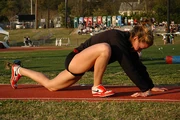
an athelete warms up before competition
Dynamic stretching consists of a series of exaggerated yet controlled motions similar in nature to the activity that follows. It is typically used as a warm up for athletes in preparation for an event or critical practice. Dynamic stretching is likely a more effective pre-workout routine than other types of stretching, such as active stretching.[1]
Dynamic stretching activates circulation of the blood, raises the core temperature[2], muscle temperature, elongates the muscles, stimulates the nervous system, lubricates the joints[1], helps decrease the chance of injury,[3] and has been shown to reduce muscle tightness.[4] Muscle tightness is one factor associated with an increase occurrence of musculotendinous tears. Dynamic stretching uses speed of movement, momentum and active muscular effort to bring about a stretch . Unlike static stretching the end position is not held, and recent scientific studies suggest that dynamic stretches before competition are preferable to static stretches.[4] This is because there are two kinds of stretch receptors, one which measures magnitude and speed and the other measures magnitude only. Static flexibility improves static flexibility and dynamic flexibility improves dynamic flexibility which is why it doesn’t make sense to static stretch prior to dynamic activity. Another reason is that there are few sports where achieving static flexibility is advantageous to success in the sport. According to the principle of specificity it would seem to be more advantageous to perform a dynamic warm-up which more resembles the activity of the sport.[3]
It should be noted that while it increases the range of motion of the joints, it does not promote as much flexibility as static stretching or PNF. This is why it is advisable for athletes to perform static stretching or PNF early on in the training plan to build the flexibility firsthand, but rely on dynamic stretching prior to competition. [2] One study compared a team that dynamically stretched to a team that static stretched. The team that dynamically stretched had fewer injuries.[3]
Typical dynamic stretches include hip, knee, arm, and ankle circles, walking lunges, high knees, etc.
Performing Dynamic Stretches[]
Dynamic stretching exercises should be performed in sets of 8-12 repetitions, with slow and controlled movements that take you gently to the limits of your range of motion.[5]
See Also[]
External Resources[]
References[]
- ↑ 1.0 1.1 Richard Quinn (January 16, 2007). Active and Dynamic Stretching: An injury prevention tandem. TheFinalSprint.com. Retrieved on 2008-05-24.
- ↑ 2.0 2.1 Dan Donche (23 July, 2007). Quick Guide to Stretching. FatalFitness.com. Retrieved on 2008-04-11.
- ↑ 3.0 3.1 3.2 unknown. (n.d.). Dynamic Stretching vs. Static Stretching. EliteSoccerConditioning.com. Retrieved on 2008-05-24.
- ↑ 4.0 4.1 unknown. (n.d.). Dynamic Stretching. Sport-Fitness-Advisor.com. Retrieved on 2008-05-24.
- ↑ Brad Appleton (n.d.). Stretching and Flexibility - Types of Stretching. CMCrossroads.com. Retrieved on 2008-05-24.